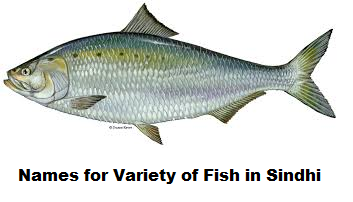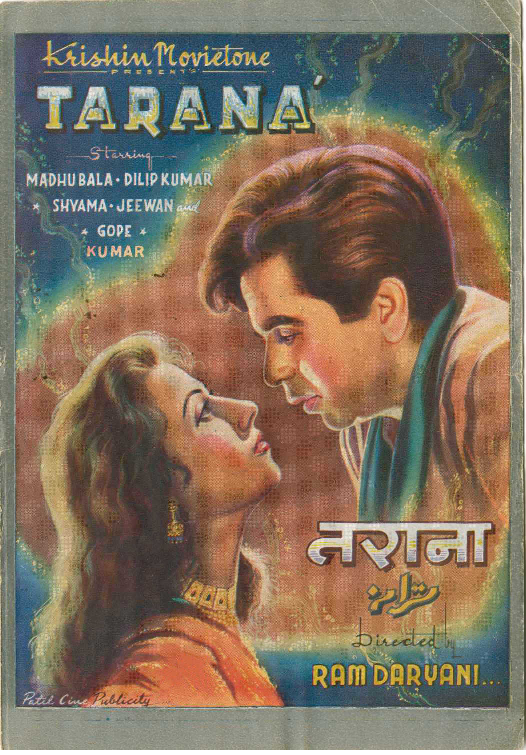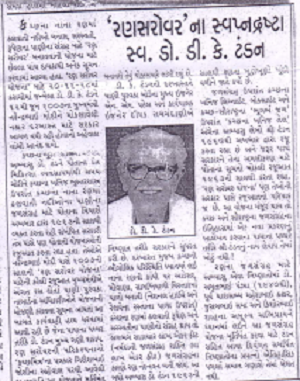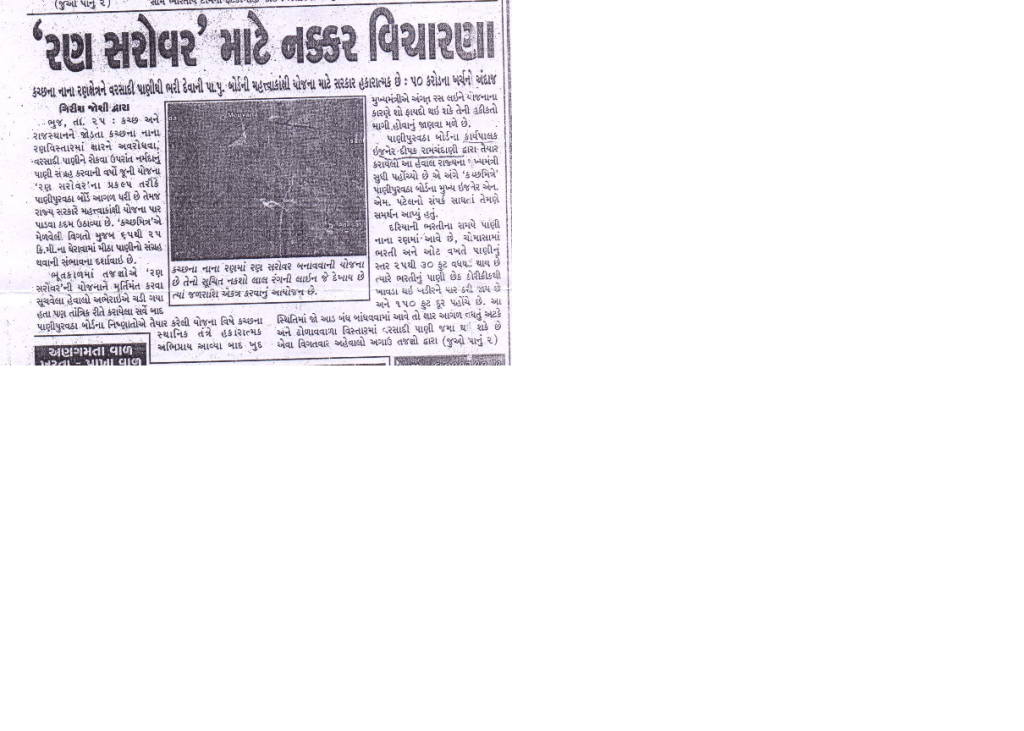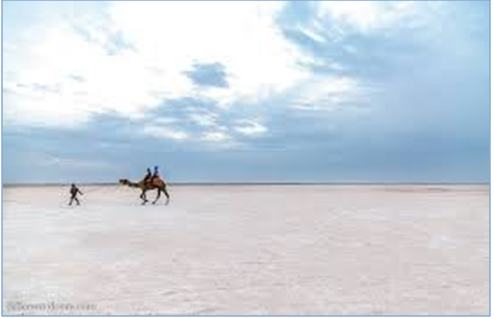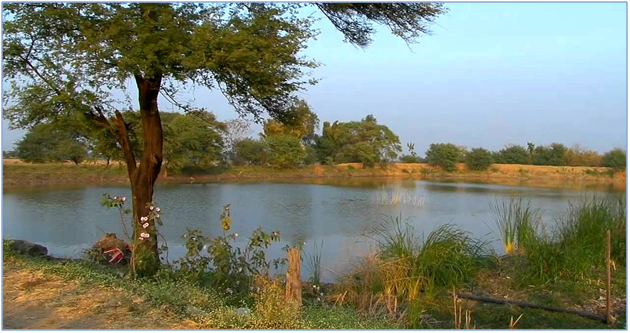
Study of Variety of Concrete Block in development of Gandhidham Township

Gandhidham Township was developed in year 1955, it was the rehabilitation township developed by Sindhu Resettlement Corporation. First time in the India , any town was totally developed by using concrete blocks in building construction. Initially lot of variety of concrete blocks were manufactured, for corners, for sills, for jambs, for soffit, for tiles, for compound wall, these variety were of hollow and solid type. Due to this variety of blocks, construction become easy and cost effective
Mohan Dayaram Bhavnani

He was first Sindhi to Direct Movies, he could be termed as Sindhi Pioneer in Film Industry
Mohan Dayaram Bhavnani was born in 1903 in Hyderabad, Sind, British India [now Pakistan].
Studied at College of Technology, Manchester (1921-4), then studied film-making in Germany at UFA (1924).
He was a director and writer, known for Mazdoor (1934), Mena Kumari (1926) and Pagal Premi (1926).
He was previously married to Enakshi Rama Rao. He died on 30 December 1962 in Bombay, Maharashtra, India.
He directed Movies such as Matri Prem ,Seth Sagarshah, Veer Bala- Year 1925, in that year 81 films were released out of which 3 were directed by Mohan D Bhavnani
In year 1926 Mohan D Bhavnani directed movies, Diwan Bhamashah, Meena Kumari, Pagal Premi, Pranay Milan, Samrat Shiladitya, Telephone Girl, Bhamto Boot, in that year 106 movies were released out of which 7 were directed by M B Bhavnani
Contribution of Sindh in Independence Movement- Alexander was defeated in Sindh
All the books of history are influenced by British, in which they always termed the attacking forces on nation as powerful. Alexander is termed as the conqueror of the world. He started from Iran and on the way towards Afghanistan he conquered almost small and big kingdoms.
He defeated Porus in India having the kingdom near Jhelum River in Punjab , Porus gave the tough fight to Alexander, due to which he did not dare to attack on Magadha which was the powerful kingdom with large army.
There was strong opposition against Alexander in Afghanistan ,also there was instability there so he wanted to return to Greece through route of Sindh. At that time Sindh was ruled by Sambas who was descendant of Shri Krishna and Jhambwanti, this was the time of 324 BC when Alexander attacked Sindh.
As per the book written by H. T. Lembark “ Sindh before Muslim conquest” When Alexander started attack on Sindh with slogan “ Al illahi “, at the first instant Sindh soldiers was shocked and ran back , their King also ran back. There after they gathered courage and planned to attack back.
At that time Brahmins were the dominating, intelligent and respectable personality in Sindh, they motivated the public to take revenge and attack, they also motivated King Sambas to attack and bear his responsibility of protection of nation.
At that time Sindh was extended up to Western Punjab and Multan. The attack on Alexander was severe by Sindh and this was the worst period of Alexander in his life.
In another book written by Plutarch” In one village of Multan, there was a camp of soldier which were termed as “Mal Pahalwan” ( Mal is the art of fighting by body builder youths of this skill are known as Mall Pahalwan). These soldiers were famous in the nation.
Reaching at this place Alexander had put himself in danger. Some these soldiers attacked Alexander and his arms were injured. One arrow penetrated his protection jacket into his chest. The attack was so deadly that he could not stand and rested on his knees. One soldier ran towards sword but was intervened by Macedonian soldier, otherwise it was the last day of Alexander. There was also rumor of Alexander’s death during this event, but he was taken by a Macedonian soldiers in safe place where he was treated.
After Alexander became healthy, he cruelty killed hundreds of unarmed Brahmins, as a revenge attack on him by Brahmin King Sambas. When Alexander returned back only 15000 soldiers were live out of 40000 soldiers, remaining died during war.
As per the biography of Alexander written by Robin Len Paul, “ Majority of the soldiers of Alexander who returned back were of opinion that they had faced maximum difficult in Sindh area during attack on the Asia.”

Parcho Vidhyarthi- Freedom Figher from Sindh

There were some freedom fighters in Sindh who dreamed of independent Sindh after freedom from British rule. The prime leader of dreaming Independent Sindh was Parcho Vidhyarthi. He Jumped the prison wall along with his companion Feru and Vishnu, police chased and fired at them, but they managed to escape without being hurt.
Parcho Vidhyarthi use to quote frequently that “No bullet of British government is still manufactured which will hit him”. British government use to fear only from Parcho Vidhyarthi in Sindh. There were many cases against him “Landi shooting case”, Madrid road loot case”, “Pinjrapol Bomb case” these were the case of looting government treasure and other.
The total verdicts of punishment were 63 years imprisonment and hang till death, hang till death sentence was replaced by 20 years imprisonment. Hence he was sentenced for total 83 years imprisonment. This was the maximum punishment of imprisonment; even Veer Savarkar was sentenced for 65 years of imprisonment. Hence he was termed another Veer Savarkar.
He was born on 15th June 1919 in village Kharo Dero of Larkana District. He studied up to B.A. He dreamed of Sindh as “Switzerland of Asia”. A book on the biography of Parcho Vidhyarthi was written by Mohan Kalpna named as “Aaftab Inqulab”. Hari Motwani also mentioned Parcho Vidhyarthi in his book “Aabo” At present he is living in Ulhasnagar.
During the visit of author Prem Motiyani in December-2006 Parcho Vidhyarthi narrated some of his memories.
Kevalram Ailiyani was father of Parcho Vidhyarthi, he was from congress party. He was sentenced to jail for two times and also participated in Dandi March. Parcho Vidhyarthi was of different opinion, he was against non violence method of seeking independence, and he never liked to beg independence from the British government. He always dreamed of Sindh as Independent country. Shri Parcho was of opinion that British government, congress and Muslim league all together cooked a conspiracy in name of independence, which shall result in new type of Ghulami (slavery) of the nation.
Hence Parcho Vidhyarthi went his own way and established “ Bharat Seva Samaj” which had two thousand student members. His prime companion was Shobo Gianchandani, Hashu Kevalramani, Jamalludin Bukhari, Amin Khoso, Ashi Vidhyarthi, Jhaman Kalani, Dayal Kalani, Narayan Wadhwani, Sakhavat Chotrani, Feru, Vishno, Amirkhan Rand Baloch, Murli Raisinghani, Nand Jethra, Atu Motwani, Santoshkumar, Preetam Tahaliyani and Khemo. Also some active women members were Kumar Hardevi, Kumari Savitri, Kumari Ishwari, Kumari Sarla Ahuja, Kumari Rajkumari , Kumari Nanki and other.
There were number of branches of “ Bharat Seva Samaj” in Sindh. The main activities were
- Attack with Bomb on Police stations
- Destroying post by acid or fire in post boxes.
- Printing and distribution of news papers
- Issuing false government orders to release their companions from prison.
- Issuing false transfer orders of government servants
- Disturbing communication system by cutting telephone wires.
When he was released from the prison in the case of Landi Shooting case, he found that nation is split into two in the name of independence. He felt that Gandhiji had not fulfilled his commitment in reference of partition.
He thought that all his activities through “ Bharat Seva Samaj” are wasted, all the efforts of his companion and risk of life taken for independence was also wasted. Even one District Tharparkar was not given to Sindhi-Hindus; his heart was lost and cried a lot. Even though he gathered courage and met Gandhiji and other leaders.
He met Mahatma Gandhi in Kolkata and Gandhi told him that “you are runaway prisoner and please do not attach his name with me, I wild advice you to surrender, but as there is rule of Muslim league in Pakistan, you will he harassed too much and shall never be released, hence I am not giving this advice, bur you shall take shelter in Gibralta.” He regularly met Mahatma Gandhi for three continuous days, he also explained the condition of Sindhis in Pakistan, but no solution was arrived and he returned to Sindh with broken heart.
Even after partition Parcho Vidharthi continued his effort of making Sindh as independent country. He was expert in changing his appearance. Sometimes he used to change his appearance as British Officer, sometimes Police Inspector and some time as Muslim Woman in Burkha (Veil), he continued his movement in different appearance. He along with his companion looted seven lakh rupees from Bank of India branch and after getting sufficient money he purchased lot of arms and ammunitions. There after he planned to attack and capture Arms factory of Sindh, Radio station, air force, etc. For this planning with the support from Bhaipratap Dialdas, he asked for help from congress leader Jayram Daulatram, Dr. Choithram Gidwani and exchanged his views. He also met Rajkumari Amrutkaur and gave his views, but nobody agreed upon his planning. He made another attempt and met Dr. Choithram Gidwani and told that Pir Pagaro is also with him along with his “Lal Sena” and if Dr.Choithram agrees upon the plan, he will be termed as leader of Sindh after successful operation, if the plan is not implemented than whole of Sindh will go from hands of Sindhis to Pakistan. He also suspected that Hindus will be harassed in Pakistan. Doctor Gidwani heard the plan of Parcho Vidharthi and asked for 24 hours to take decision, and within these 24 hours he left Pakistan through aircraft and reached India.
Names in Sindhi for Variety of fish
Satram Rohera- Producer of Film Jai Santoshi Maa

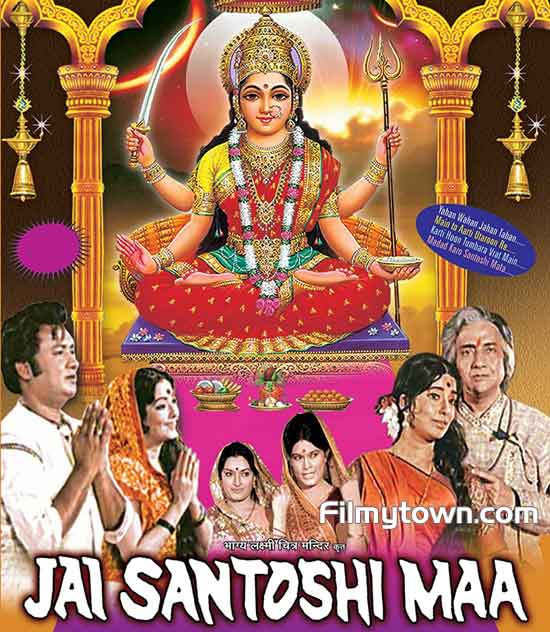
Satram Rohera has produced many movies out of which one is Jai Santoshi Maa
He also produced commercial movie such as Rocky mera Jaam in 1973 in which Sanjeev Kumar was lead actor, he also produced movie Navan Sahab, Jai Kali and Ghar Ki laaj.
Jai Santoshi Ma was the classic example of profit on investment.
This movie was produced at the cost of Rs 25 lakhs and earned about Rs 5 crores, hence the movie earned 20 times the investment
In the same Year there was the another block bluster movie Sholay produced by G.P. Sippy and Directed by Ramesh Sippy, cost of production was Rs 3.0 crores and box office collection was Rs 35 crores i.e about 11 times the cost of production.
In todays block bluster movies, production cost is very high and if collection crosses the investment it is successful, but Jai Santoshi Ma movie has amazing sucess even though very low budget movie.
Music was very meledous and songs were composed by C. Arjun, i.e Arjun Parmanand Chandnani
Ram Daryani- Film Director & Kumar Daryani screen play writter and Producer
Ram Daryani was the Director of Hindi Movies, his famous film was Tarana in which Dilipkumar and Madhubala were lead actor.
His first movie was Khun- E- Nahak in 1935, he directed 24 movies till 1960.
HIs movies were Khun- E-Nahak, Sangdil Samaj, Pratima, Gentelman Daku, Zamana, Hindustan Hamara, Pyas Dukh Sukh Kurbani, Chirag, Preet , Panadai, Doosri Shadi, Shravankumar, Ghar Ki Izzat, Ma Ka Pyar, Bhooli, Bhai Bahan, Badi Bahan, Tarana, Pahili Shadi, Majboori, Mumtaz Mahal and Chand Mera Aaaj in 1960.
His brother Kumar Daryani was writer and film producer.
Kumar Daryani wrote screen play for Tarana, Ghar Ki Izzat, Shravan kumar and Doosri Shadi.
He produced one movie Tarana in the name of his company Krishin Movitone.
Moti B Gidwani- film director
Moti B Gidwani was the Film Director at the time of Un Divided India
He was born in Year 1905
He started his film career as Director in 1929 with Film Nisha Sundari
He directed 20 films and produced one film Khazanchi
His directed films were Nisha Sundari, Veer Na Ver, Josh E Javani, Dav Pech, Ghulam, Alangsena , Nurani Moti, Insan Ya Shaitan, Daku ki ladki, Noor Mahal, Manjari, Gulam Daku, Kisan Kanya, Do Aurtey, Yamla jat, Khazanchi, Ek faisla, Zameendar, Kaise Kahoon and Khamosh Nigahe was his last directed movie in year 1946
Tappar Reservoir- Case Study
Rann Sarovar
રણ સરોવરની કલ્પનારણ સરોવરની કલ્પના
દીપક જી. રામચંદાણી અધિક્ષક ઇજનેર(સિવિલ) ૧૨-૧૦-૨૦૧૬રણ સરોવરની કલ્પનાકચ્છ જીલ્લો ગુજરાત રાજ્યની લગભગ ૨૫% જેટલો જમીનનો હિસ્સો છે. આ જીલ્લામાં કોઇ પણ બારમાસી નદીઓ નથી. ઐતિહાસિક વાત કરીએ તો અમુક નદીઓ જે ઉત્તરથી આવી અને કચ્છમાં પૂર્ણ થતી તે લુપ્ત થયેલ છે. સિંધુ નદી: અગાઉ સિંધુ નદીનું પાણી કચ્છ સુદે પહોંચતું અને હાલ જે બન્ની વિસ્તાર કહેવાય છે, જ્યાં આજે બાવળિયાઓ સિવાય કાઇ જોવા મળતું અથી ત્યાં વિપુલ માત્રામાં ચોખાની પેદાશ થતી હતી અને આ જથ્થો બે થી ત્રણ રાજ્યોને પુરો પાડવામાં આવતો.
(લુપ્ત થયેલ નદીઓ – સિંધુ, સરસ્વતી અને લુણી )
વર્ષ ૧૮૧૯માં એક મહાકાય ભુકંપ થયો જેના કારણે જમીનમાં ૮૦ માઇલ લંબાઇ, ૧ માઇલ પહોળાઇની જમીન તેની સપાટીથી અમુક મીટર ઉપસી આવેલ. આ જમીને સિંધુ નદીનું પાણી રોકી લીધુ અને આ કુદરતી બંધને લોકોએ “અલ્લાહ બંધ”નું નામ આપ્યું. (અલ્લાહ બંધ)
વર્ષ ૧૮૧૯ પહેલા બન્ની વિસ્તારમાં સિંધુ નદીનુ પાણી જોવા મળતું હતું, વર્ષ ૧૮૨૪માં અંગ્રેજ આર્મી ઓફિસર મૅક મુર્ડો કચ્છના બન્ની વિસ્તારનો અભ્યાસ કરેલ અને તેમને સિંધુ નદીના પાણીની જગ્યાએ દરિયાનું ખારૂં પાણી જોવા મળેલ. ખારૂં પાણી અમુક માસ સુધી બન્ની વિસ્તારમાં રહે છે અને તાપમાનના હિસાબે જમીન પર મીઠાનો થર જામવા લાગે છે. વર્ષોની આ પ્રકિયા પછી બન્નીના અમુક ભાગ પર મીઠાનો મોટો થર જામતા તે સફેદ રણમાં પરિવર્તન થયેલ છે. આ સફેદ રણમાં દર વર્ષે ધોરડો ગામ નજીક “રણ ઉત્સવ” યોજવામાં આવે છે. સફેદ રણસિંધુ નદી સિવાય સરસ્વતી નદી પણ કચ્છ સુધી આવતી અને તે સમયમાં હડ્ડપન સંસ્કૃતિ વખતે ધોળાવીરાનો વિકાસ થયેલ, જેના અવશેષો આજે પણ જોવા મળે છે. ધોળાવીરા કચ્છના ખડીર બેટ પર આવેલુ છે અને ત્યાંના મળેલા અવષેશો લગભગ ૫૦૦૦ વર્ષ જુના છે.
(ધોળાવીરા – તાલુકો ભચ્ચાઉ – કચ્છ) અગાઉ રાજસ્થાનથી નીકળતી લુણી અને બનાસ નદીનું પાણી પણ કચ્છ સુધી પહોંચતું હતુ અને હાલ જો અતિ વરસાદ થાય ત્યારે જ બનાસ નદીનું પાણી કચ્છ સુધી પહોંચે છે અને સુરજવાડી ક્રીક મારફતે દરિયામાં વહી જાય છે. જુનો ઇતિહાસ જોયા પછી ફરીથી કચ્છ વિસ્તારને ધમધમતો કરવા માટે “રણ સરોવર”ની કલ્પના કરવામાં આવી છે. આ કલ્પના સ્વપ્ન જેવી નથી પરંતુ હકીકતે થઇ શકે તેના માટે એક તાંત્રિક અહેવાલ પણ બનાવવામાં આવેલ છે.
વર્ષ વસ્તી(લાખમાં)૧૭૪૪ ૧૦૧૮૨૧ ૫૧૮૨૩ ૩.૫૨૦૦૧ ૧૫.૫૩૨૦૧૧ ૨૦.૯૨ પાણીના અભાવે અને નદીઓના કચ્છ તરફ આવતા વહેણો રોકાઇ જતા વસ્તીમાં ઘટાડો થયેલ માલુમ પડેલ છે. એક જુના દસ્તાવેજ મુજબ વર્ષ ૧૭૪૪માં કચ્છ્ની વસ્તી ૧૦ લાખ જેટલી અંદાજવામાં આવેલ. વર્ષ ૧૮૧૯માં ભુકંપ આવવાના કારણે સિંધુ નદીનું પાણી રોકાઇ ગયેલ અને કચ્છને મોટો સામાજીક અને આર્થિક ફટકો પડેલ જેનાઅ કારણે વર્ષ ૧૮૨૧માં વસ્તી ગણતરીના અંદાજ મુજબ ૫૦% ઘટાડો થયેલ છે અને વર્ષ ૧૮૨૩માં વસ્તી ગણતરીના અંદાજ મુજબ કચ્છની વસ્તી માત્ર ૩.૫૦ લાખ થઇ ગયેલ હતી. વસ્તી ગણતરીના છેલ્લા વર્ષ ૨૦૧૧ મુજબ કચ્છની વસ્તી ૧૫.૫૩ લાખ અંદાજવવામાં આવેલ છે. આમ તારણ કાઢીએ તો પુરતા પાણીના અભાવે કચ્છનો વિકાસ રોકાઇ ગયેલ છે. વિકાસની એક વાત કરીએ તો કચ્છમાં આવેલ લખપત મુકામે એક મોટો બંદરગાહ હતો, જ્યાંથી માલસામાનની હેરફેર માટે એકલા વહાણોની અવરજવર થતી કે જે તે વખતે લખપત બંદરની દૈનિક આવક એક લાખ કોડીની હતી. જેના પરથી આ બંદરનું નામ આપવામાં આવેલ. આજે આ જગ્યામાં એક નાનકડુ ગામ છે અને જુના અવશેષો જોઇ શકાય છે. લખપતમાં શ્રી ગુરુનાનક દેવજીએ મક્કા જતી વખતે રોકાણ કરેલ હતુ અને હાલ લખપતામાં એક ગુરુદ્વારા છે જેમાં શ્રી ગુરુનાનક દેવજીની ચાખડીઓ રાખવામાં આવેલ છે.
કચ્છનો સિતારો ફરીથી બુલંદ કરવા માટે “રણ સરોવર”ની કલ્પના કરવામાં આવી છે. આ કલ્પના સાકાર કરવા માટે જરૂરી કામોની વિગતો નીચે મુજબ છે. ૧. સુરજબારી પાસે પુલના સમાંતર બંધ બાંધી, કચ્છના નાના રણમાં આવતા પાણીને રોકીને સરોવર બનાવવું. સુરજબારી પુલના ઉપરવાસમાં પાણી રોકવા માટે જુના બ્રિજનો ઉપયોગ કરે શકાય. માત્ર ઘુડખર અભ્યારણની મંજુરીનો પ્રશ્ન ઉપસ્થિત થાય છે.
૨. ઘડુલી સાંતલપુર રસ્તાના થનાર બાંધકામને માટી બંધ તરીકે ઉપયોગ કરી કચ્છના મોટા રણમાં જીલ્લાની મેઇન લેન્ડથી ઉત્તર તરફ વહેતી નદીઓના પાણી ટ્રેપ કરી સરોવર બનાવવું. આ બાબતે એક દસ્તાવેજમાં ઇસરોના વૈજ્ઞાનિકશ્રી કે.એલ.એન શાસ્ત્રીનુ પણ સમર્થન છે. ઘડુલી – સાંતલપુર રસ્તાનું કામ માર્ગ અને મકાન વ્યવહાર વિભાગ હસ્તક છે. આ રસ્તાની જોગવાઇ મુજબ કચ્છ જીલ્લાના ઉત્તર-પશ્ચિમ છેડે આવેલા ઘડુલીથી શરૂ કરી કચ્છના મોટા રણમાંથી પસાર થઇ ખાવડા અને ખડીર જેવા રણ બેટને જોડી બનાસકાંઠાના સાંતલપુર સુધી રસ્તો બનાવવાના છે. રજુઆત કર્તાના સુચન મુજબ જો રસ્તામાં બનનાર ક્રોસ ડેનેજના નાળામાં સ્લુસ વાલ્વ મુકવાથી, કચ્છ મેઇનલેંડથી ઉત્તર તરફ વહેતી નદીઓના રણમાં વહી જતા પાણીનું જળાશય બનશે. હાલની જમીનની ખારાશના કારણે જ્યારે આ પાણી ખારૂં બની જાય ત્યારે નાળાના સ્લુસ વાલવ ખોલીને ખારૂં પાણી ઉત્તરના રણ તરફ વહાવી દેવાથી, કેટલાક વર્ષે આ જળાશય મીઠા પાણીનું જ બની જશે. આ બાબતે જણાવવાનું કે, આ રસ્તાનું કામ માર્ગ અને મકાન વિભાગ હસ્તક છે. રણમાંથી પસાર થનાર ઉક્ત રસ્તાના મથાળાના લેવલ, રણની જમીનના લેવલ રસ્તામાં મુકવામાં આવેલ ક્રોસ ડ્રેનેજની વિગતો તથા બનનાર જળાશયના બેઝીન અને કચ્છ મેઇનલેન્ડનો ડુબાણ જનાર વિસ્તાર વગેરે બાબતોને ધ્યાને રાખીને આ બાબતે વિગતવાર સર્વે કરવામાં આવે તો કોઇ નિશ્ચિત અભિપ્રાય પર જઇ શકાય.
૩. કચ્છ મેઇન લેન્ડ પરથી ઉત્તર તરફ વહેતી નદીઓ જ્યાં રણને મળી છે તેની આજુબાજુ બંધ બાંધી જળસંગ્રહ એકમો ઉભા કરવા. આના માટે એક સર્વેક્ષણ કરી જુદી જુદી જગ્યાએ નાના નાના બંધ બાંધી પાણી દરિયામાં જતું અટકાવી શકાય. દા.ત કચ્છથી રાધનપુરના રોડ ઉપર આવેલ આડેસર નજીક ક્રિક પર બંધ બાંધી શકાય. રાપર તાલુકાના એક લાકરાવાંડ ડેમ આવેલ છે. તે ડેમ ખાસ કરીને ક્ષાર નિયંત્રણ માટે બનાવવામાં આવેલ. આ ડેમની આજુબાજુ હાલ ૩૦૦ થી ૪૦૦ ખેડુતો લાભ લે છે અને આ ડેમ કાર્યરત થયા પછી તેમની જીવનશૈલીમાં સુધાર આવેલ છે. તોલાણી પોલીટેકનીકના લેક્ચરરશ્રી રવિ ગુરનાણી જ્યારે તેમને માસ્ટર ડીગ્રી કરવા માટે વિષય અંગે મારાથી ચર્ચા કરેલ ત્યારે લાકરાવાંડ ડેમને “રણ સરોવર”ના પાઇલોટ તરીકે ગણીને અભ્યાસ કરવા સુચવ્યુ. આ અભ્યાસનો અહેવાલ બે આંતરરાષ્ટ્રીય મેગેઝીનોમાં પ્રસિધ્ધ થયેલ છે.
ભુજથી ખાવડા આશરે ૭૦ કી.મીના અંતરે આવેલ છે, ખાવડા પછી બોર્ડરના રસ્તે આશરે ૨૦ કી.મી પછી ઇન્ડીયા બ્રિજ ઉપર જો ડેમ બનાવવામાં આવે તો ખાડીનું પાણી બન્ની વિસ્તારની જમીનમાં જતુ અટકી શકે અને વરસાદનું પાણી ખાડીમાં જતુ અટકે જેના કારણે ક્ષાર નિયંત્રણ થાય અને જમીન ફળદ્રુપ બની શકે.
રણ સરોવર પ્રોજેક્ટ રીપોર્ટ
NAME OF PROPOSAL: TO INTERCEPT WATER OF RIVERS FROM RAJISTHAN AND OTHER PARTS OF GUJARAT IN KACHCHHFacts about Kachchh: Kachchh district is surrounded by the Gulf of Kachchh and the Arabian Sea in south and west, while northern and eastern parts are surrounded by the Great and Small Rann (seasonal wetlands) of Kachchh. When there were not many dams built on its rivers, the Rann of Kachchh remained wetlands for a large part of the year.Bhuj is the district head quarters of Kutch district. The district covers an area of 45, 652 sq. km with total population of 15, 26,321 according to 2001 census.The Great Rann of Kutch, along with the Little Rann of Kutch and the Banni grasslands on its southern edge, is situated in the district of Kutch and comprises some 30,000 square kilometres (10,000 sq mi) between the Gulf of Kutch and the mouth of the Indus River in southern Pakistan. The marsh can be accessed from the village of Kharaghoda in Surendranagar District.The Rann is famous for its marshy salt flats which become snow white after the shallow water dries up each season before the monsoon rains.In India’s summer monsoon, the flat desert of salty clay and mudflats, averaging 15 meters above sea level, fills with standing waters, interspersed with sandy islets of thorny scrub, breeding grounds for some of the largest flocks of Greater and Lesser Flamingoes, and is a wildlife sanctuary [7]. At its greatest extent, the Gulf of Kutch on the west and the Gulf of Cambay on the east are both united during the monsoon.The district is also famous for ecologically important Banni grasslands with their seasonal marshy wetlands which form the outer belt of the Rann of Kutch.The total area of Kachchh covers about 25% of area of Gujarat where as population of the area is only 2.5 % of population of Gujarat.There are no perennial rivers in Kachchh, all the seasonal rivers emerges from the mountain range of Kachchh and ends up to the sea.Some ancient facts about the rivers: The Ghaggar River: which presently empties into the desert of northern Rajasthan, formerly emptied into the Rann of Kutch, but the lower reaches of the river dried up as its upstream tributaries were captured by the Indus and Ganges thousands of years ago. Traces of the delta and its distributary channels on the northern boundary of the Rann of Kutch were documented by the Geological Survey of India in 2000.Sindhu river :- Till year 1819 Indus river ( Sindhu river) use to flow into the Kachchh due to which there was great prosperity in the area. In year 1819 due to earthquake “ Allahband” ( Natural dam ) was created on the mouth of river Indus. This resulted in blockage of water entering in the Kachchh.Traces of Saraswati river: Canal structures of Ancient KUTCH SARASWATI Civilisation during the Harappan and post Harappan times.
Many of us have visited Dholavira and seen water reservoir of the ancient time of Saraswati civilisation time.
But we do not see the actual irrigation channels of the water which brings the water to those reservoir nor the DAM area to elevate the water level of the river so water can travel through those channels to the reservoir with gravity force only.
But That’s the actual Beauty and the importance of those ANCIENT Architect of WATER Irrigation Engineering during the Ancient time of Saraswati civilisation time.
Traces of ancient civilization : Dholavira is Harappan site located in the Great Rann of Kachchh on a Khadir Bet. At present the Rann is a dry area but during good monsoon it gets flooded. Dholavira is supposed to have witnessed the earliest habitation of protohistoric period in Gujarat. Excavation has revealed a long cultural sequence which commences from the beginning of the third millennium BC, when perhaps a group of people from Makran coast arrived on the island through Kori creek. This assumption is based on the ceramic feature resembling those from the Amerian culture (datable to 3000 BC). Similar pottery has also been reported from other Harappan sites of Kachchh. The base of Rann of Kachchh might have been under 10 m deep water for 3000 years19 and the Khadir Bet could have served as an island in the shallow sea. It is not clear why people settled on an island rather than on the mainland, where agriculture and other commodities, including marine resources could be better exploited. The inference is that Dholavira was an active port and the Harappans must have found that this port was a safe harbour for anchoring boats. The long habitational history of the area highlights the importance of the location and of maritime activities. The location of the site seems to be favourable even for riverine navigation, in case one is not inclined to consider this a port site.The Great Rann and Little Rann are unique examples of Holocene sedimentation. The two Ranns represent filled-up gulf and mark the site of accumulation in an estuarine delta environment that was marked by a fluctuating strandline since the advent of Holocene. Gupta28 mentioned that ‘Holocene sediments of the Little Rann and Nal Lake were contemporaneous’. The lowermost sandy clay horizon extends from about 9000 BP to about 4200 BP overlain by the silty clay horizon dating from 4200 to 1500 BP and then again by the most recent silty clay horizon’. He further suggested that even as late as 2000 years ago, Little Rann was about 4 m deep and thus was inundated throughout the year.There are also evidences of earthquake from phase III of Dholavira in Khadir Bet of Rann of Kachchh30 which may be datable to around 2200 BC. Perhaps the effect of earthquake such as collapse of houses and diversion of drainage system, and finally the uplift of Rann were responsible for the decline of Harappans at Dholavira. There are evidences of navigation in the Rann of Kachchh during the historical period. The author of Periplus of Erythraean Sea writes ‘Beyond the river Sinthus there is another gulf, not navigable, running in towards the north; it is called Eirinon; its parts are called separately the small gulf and the great; in both parts the water is shallow, with shifting sand-banks occurring continually and a great way from shore; so that often when the shore is not even in sight, ships run aground, and if they attempt to hold their course they are wrecked.Necessity of the proposal:- Due to trace of ancient rivers there was prosperity in the Kachchh , hence the population of Kachchh in year 1744 was estimates as 10,00,000 which was reduced drastically after the stoppage of surface resources , after creation of Allahband the population in year 1821 of Kachchh was reduced to 50% i.e only 5,00,000 only and which was reduced further to 3,50,000 in year 1823. The social economic balance was disturbed which resulted the decrease in prosperity and population. Hence now it is again time to make efforts to revive the same.Proposal: Water from river Luni of Rajasthan , Banas and other small tributaries of mountain region enters in Rann of Kachchh and is lost in the sea without any utility , hence it is proposed to tap the water and accommodate in the Rann of Kachchh.About river Banas: The West Banas is a river of western India. It originates the southern Aravalli Range, in Sirohi District of the state of Rajasthan. It flows south, draining the valley between Mount Abu on the west and the easterly ridge of the Aravallis on the east. It continues south through the plains of Gujarat state, flowing through Banaskantha and Patan districts to empty into Little Rann of Kutch seasonal wetland. Banas River Basin is located in east-central Rajasthan, between latitudes 24o15′ and 27o20’N and longitudes 73o25′ and 77o00’E. Aligned NE-SW, it is bounded by the Luni Basin in the west, the Shekhawati, Banganga and Gambhir Basins in the north, the Chambal Basin in the east, and the Mahi and Sabarmati Basins in the south.
The Basin extends over parts of Jaipur, Dausa, Ajmer, Tonk, Bundi, Sawai Madhopur, Udaipur, Rajsamand, Pali, Bhilwara and Chittorgarh Districts.The total catchment area of the Basin is 45,833 km2 according to the 1:250,000 scale topographical maps published by the Survey of India.About Luni river:- The Luni is a river of western Rajasthan state, India. It originates in the Pushkar valley of the Aravalli Range, near Ajmer and ends in the marshy lands of Rann of Kutch in Gujarat, after travelling a distance of 530 km. It is first known as Sagarmati, then after passing Govindgarh, it meets its tributary Sarsuti, which originates from Pushkar Lake, and from then on it gets its name Luni.In 1892, Maharaja Jaswant Singh of Jodhpur constructed Jaswant Sagar in Pichiyak village between Bilara and Bhavi of Jodhpur district. It is one of the largest artificial lake in India, and irrigates more than 12,000 acres. Works required to be carried out: To construct a bund along Surajbari bridge so that flood water from the above mentioned rivers may not enter into the sea. Also similar structure is required to be constructed near India Bridge near Khavda.Due to above works the flood water of the above catchment and rivers shall be accommodated in Rann of Kachchh and large quantum of water could be stored. In the recent news on TV-9 it was displayed that due to construction of temprory bund for the work of 3rd Surajbari bridge huge quantity of water from Banas river had acculumated , the new also displayed the vast area of land covered with the water of river Banas. Hence if some permanent measures are to be made for interception of water , Kachchh can store huge quantity of fresh water on the land.Bottle necks: Business of salt industries shall be affected and also business of fisheries to some extent.
PAPER PUBLISHED IN INTRNATIONAL MAGAZINE REGARDING “LAKARAVAND DAM” WHICH IS PILOT STUDY OF “RANN SAROVAR”
Camel-
My Memories
Preamble:
This is not in any way effort to write Biography, but defiantly I am fond of reading and writing.
I took the opportunity to divert my mind in this Pandemic of Covid-19 and in free time I started writing my memories and also liked to share my some old post on social media.
My memories shared in this document does not contain anything related to my office position and my social memories.
This is broadly regarding the issues which any one may like to read.
Some details of my grandparents are given so that my children may read some times in future to know about their ancestors.
The contain in this document also contain some names , I think the reference given does not hurts their sentiments.
Amils
About Amils:
About our Ancestor ” Amils:-
Since ancient times, Hindus in India have remained divided into castes like Khatris, Lohanas etc. Castes actually denote the original professions followed by the families in which people were born. Those who migrated to Sind from various corners also belonged to different castes some of them were followers of Sikhism. Thus many different faiths, castes and cultures gathered in Sind. That is why we Amils have no single caste and are casteless. Those migrants who acquired education and became scholars were called as “Alim” or “Vidyawan”. Those that after getting education put the education into action (the word for action being “amal”) were called “Amils” And those Hindus that entered the Government service were alled “Amils” and “Diwans”.
From written sources collected by an eminent author (Bherumal Meharchand) in 1919, from newspapers, historical publications, personal interviews, it was found that most of the Amils then residing in Sind had come from nearby Multan and Unch in Punjab. A few Amils were Khatri Lohana, which are warriors by caste who embraced Sikhism while in Punjab. They migrated to Sind after Hindus came under persecution and evil influence when Aurangzeb became emperor.
Such persecutions and evil influence usually forces victimized people to flee the place of their residence. Many consider this as one of the major reasons for migration from Punjab and other places to Sind which was ruled by Talpurs also
It may not be necessary that the ancestors of present day Amils migrated only because of Aurangzeb’s persecution. This may have been the initial cause of migration to Sind that probably commenced from 1670. Thereafter some people went to Sind for the sake of service with Sind rulers or for business and settled down there. In the case of some it is certain that they went to Sind for the sake of service only.
About our Ancestor ” Amils:-
Since ancient times, Hindus in India have remained divided into castes like Khatris, Lohanas etc. Castes actually denote the original professions followed by the families in which people were born. Those who migrated to Sind from various corners also belonged to different castes some of them were followers of Sikhism. Thus many different faiths, castes and cultures gathered in Sind. That is why we Amils have no single caste and are casteless. Those migrants who acquired education and became scholars were called as “Alim” or “Vidyawan”. Those that after getting education put the education into action (the word for action being “amal”) were called “Amils” And those Hindus that entered the Government service were alled “Amils” and “Diwans”.
From written sources collected by an eminent author (Bherumal Meharchand) in 1919, from newspapers, historical publications, personal interviews, it was found that most of the Amils then residing in Sind had come from nearby Multan and Unch in Punjab. A few Amils were Khatri Lohana, which are warriors by caste who embraced Sikhism while in Punjab. They migrated to Sind after Hindus came under persecution and evil influence when Aurangzeb became emperor.
Such persecutions and evil influence usually forces victimized people to flee the place of their residence. Many consider this as one of the major reasons for migration from Punjab and other places to Sind which was ruled by Talpurs also
It may not be necessary that the ancestors of present day Amils migrated only because of Aurangzeb’s persecution. This may have been the initial cause of migration to Sind that probably commenced from 1670. Thereafter some people went to Sind for the sake of service with Sind rulers or for business and settled down there. In the case of some it is certain that they went to Sind for the sake of service only.
Pond- Basic of Civilization
My Father
My Father:
10 years ago on the same date , my father left us for heavenly abode.
On 3rd December 2008, I came to Gandhinagar for the Technical Scrutiny Committee, just after completing the meeting , I got a call from my uncle who gave me this sad news, and I immediately rushed to my home at Adipur.
Before I reach Adipur, all my friends reached my home and they were with my family members and made all arrangements for funeral. I am still thankful to my friends
Today ten years has passed, I still remember that my father use to wake up in early morning and I moved for Gandhinagar on the 3rd Devember 2008, my father asked that why you are frequently going to long tours, he was no comfortable on that day.
My father came to India after partition , at that time he was 7 years of age and first came at Varsha Coloney Vadodhara and there after they moved in Ulhasnagar Camp-1 and lived in barrack.
Later my Grand Parents shifted at Adipur and against claim settlement got three houses and they shifted to Adipur.
My Grandfather Shri Kalachand was a Chemist and started working in Medical Shop of one Mr.Lal Vaswani
My father cleared ITI in fitting and started a Job in Tolani Foundation Gandhidham Polytechnic as Fitting instructor. He was the founder member of TFGP
I learned the fitting jobs from my father during my studies in TFGP during the first year in 1981.
My father was hard working and he always liked to do part time job after the teaching hours, I remember he use to work as operator of Usha Talkies ( Now Vinay cinema), Movies were free for us and I watched almost every movie with my father when I was child.
He also started a shop on the Maitry road Adipur of bakery Items, when I was child , use to sit in the shop in the evening, then he sold the shop to one Kishin Tailor and still this shop exist and next generation of Shri Kishin are operating this shop.
During the last few years before retirement , he started visiting the Radha Krishin temple of Divine Life Society every evening.
He was very fond of feeding the birds, hundreds of parrots use to come to our house when my father use to give grains, but cats use to hunt them frequently as it was each catch due to large number of birds at one place, so my father discontinued.
He retired in year 1998, in the same year my son Yash was born and he became busy in taking care and playing with him.
I started the Job in 1983 and both father and son worked parallel for about 15 Years, there was mistake of 2 years in age of my father registered during employment , otherwise he would have retired in Year 2000.
He was follower of Radha Swami and had become vegetarian , he used to mediate for number of hours and in year 2003, it was day of Shivratri , he was meditating and locked himself in the room and was not opening , when we forced him and came out of the room , but lost the mental balance for which his treatment was continued for some time. But he lived the normal life except on some occasions we have to make counseling.
Overall he was healthy, without any disease of Blood pressure or Diabetes
During the entire life he was very Kind to the family and never gave any trouble to use.
Yesterday I spoke to my Mother , about the ten years passed without my Father and today my Wife reminded me in the morning that 10 years has passed and we remember him very much.
Tappar Reservoir- A Case Study
Tappar Reservoir- A Case Study

Lost touch on Word Press
Due to over load of official works in my department, i had lost touch on Word Press, and not posted since long
During the Year 2018, I will try to save some time to put up my thoughts on Word Press
Making of Gandhidham- The township of Kachchh , Gujarat
Dangal: A Must watch movie in Theater
This Saturday on 7th January 2017, I watched Dangal along with family in SB Multiplex. This is the movie which every on shall watch in the theater.
The best part was that except Aamir Khan all the other Key actors were new and less known.
All the songs were background songs which make the movie realistic. The only song which was not a back ground song was a marriage song which looked realistic as in every marriage such type of songs are sung in almost every community.
Actors of the movie does not belong to Hariyana but there was good command in their language.
“ Babu Sehat Ke Liye” was the best song of the Movie.
There was a climax insident in which Music National Anthem was played when Geeta won the gold medal, during such incident majority of the audience of the movie stood up at their places to respect the National Anthem. This was the situation when I felt proud about my Nation and citizen of the Nation.


